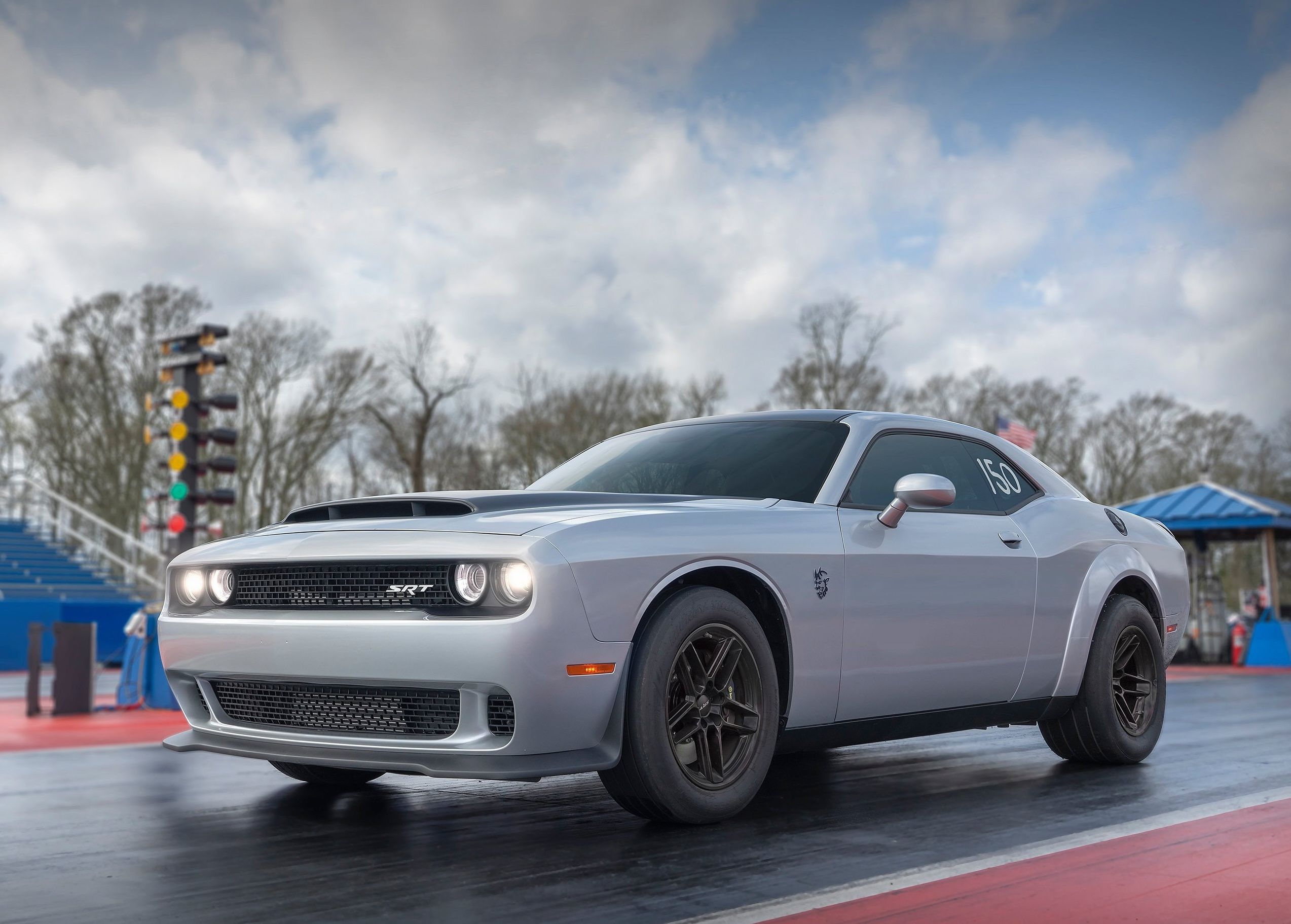Quick Links
-
Defending My 0-60 MPH And Quarter-Mile Statement
-
Can You Measure The Power Density Of An EV Motor?
If you’re a regular reader, you might have noticed that we’ve been focusing on power density a lot recently. While these articles are fun to write, they’re part of a larger focus on informing, but also entertaining. The days when 0 to 60 mph, quarter-mile times, and top speed were the beginning and end of performance cars are nearing an end, and we’ll explain why these metrics are outdated a little later on.
The automotive language of the future will focus on power – but not at the expense of efficiency – and the best way to illustrate the concept is by using power density or specific output if you prefer. In basic terms, the specific output of an engine is its power output divided by the engine size.
A Basic Comparison
To illustrate how a car can be both powerful and efficient, let’s start by comparing two very different engines. The third-generation Dodge Viper is equipped with an 8.4-liter naturally aspirated V10 engine that produces 645 horsepower. The brand-new Mercedes-AMG C63 S E Performance has a 2.0-liter turbocharged four-cylinder producing 469 hp – this is a plug-in hybrid, so it uses electrical gadgetry to add to those outputs for a total of 671 hp, but that’s not important for the purposes of this example. For now, we’ll focus on just the turbo-four engine that puts out 469 hp.
Power Density
Power density refers to the amount of power generated per unit of volume (of the engine).Thus, ‘specific output‘ refers to horsepower per liter.
If we apply the basic formula mentioned above, the Viper has a specific output of around 77 hp per liter, where specific output refers to how much horsepower is produced for every liter of engine displacement (ie: 645 hp divided by 8.4 liters = 76.7 hp, rounded up to 77 hp). The C63’s specific output, by comparison, is more impressive: 469 hp divided by 2.0 liters gives us 234.5 hp/l. The AMG’s engine is less than a quarter of the size of the V10 in the Viper, yet it produces three times more power when we measure the power density.
Why Does It Matter?
There are loads of reasons why this matters, and we’ll explore them at the moment, but for now, let’s just look at the fuel consumption figures of the cars mentioned above. According to the EPA, the Viper consumes 14 mpg on the combined cycle, and we know from real-life experience that the C63 consumes roughly 17 mpg when you’re driving like a normal person; in other words, not hypermiling like a boss.
Because an engine’s main function is to turn the latent power in the fuel into forward momentum, at the most fundamental level, you’re spending more money to move a more powerful and less efficient engine over a shorter distance. The Viper does sound better, though – we’ll give it that. Other than fuel economy benefits, here are other reasons why automakers focusing on specific output matters.
Downsizing
|
Model |
2021 Chevrolet Silverado 2WD |
2022 Chevrolet Silverado 2WD |
|
Engine |
3.6-liter NA V6 |
2.7-liter turbocharged four-cylinder |
|
Power |
285 hp |
310 hp |
|
Specific Output |
79 hp/l |
115 hp/l |
|
Fuel Consumption (Combined) |
17 mpg |
20 mpg |
Think of all the first world countries across the globe as a governing body for motorsport. It’s sitting on one side, and they’ve told the automakers of the world that their cars are only allowed to produce a certain amount of emissions, which is boring. On the other side, you have the gearheads who are still demanding the same power output. We can demonstrate this, using the new C63 and its predecessor. Despite having way more power, it has an emissions rating of 156 grams per kilometer. The previous twin-turbo V8 C63 emitted 312 g/km.
But let’s move away from the high-end stuff and into the real world. Up until the 2021 model year, the base Chevrolet Silverado 1500 was equipped with a 3.6-liter NA V6 that produces 285 hp and consumes 17 mpg on the combined cycle. When the new model rolled out in 2022, it was equipped with a turbocharged 2.7-liter four-pot with 310 hp on tap, and a thirst rating of 20 mpg combined. That’s more power and a lesser appetite for fuel. The 2024 Silverado is still available with a 5.3-liter NA V8, but its specific power output is a paltry 67 hp, so it’s even less power-dense than the axed V6.
Smarter Packaging And Affordability
The actual measurement we use for engine capacity is cubic centimeters, or cc. It’s basically a measurement of the fuel and air that can be pushed through the cylinders. We commonly refer to it as liters because it’s a volume. So a 1,998 cc engine is usually rounded up to two liters. The smaller the engine in capacity, the smaller it is physically, which is helpful in many ways. In the rest of the world, 1.0-liter turbocharged engines are common because they fit nicely into the front of hatches that wouldn’t sell so well in the United States.
A smaller engine also means you can play around with the layout of a car more, which is relevant across multiple car segments. At the bottom end, you have the GR Corolla, which has a turbocharged three-cylinder mounted further back than it would have been if Toyota used a supercharged V6. This leads to better weight distribution, which results in a more pleasing driving experience. Did you know that Honda’s most power dense engine ever doesn’t belong to the Acura NSX? It sits under the hood of the Civic Type R. How’s that for giving specific power output to the people?
We can also take it to the extreme with the most power-dense engine currently in production. It’s the 2,880 cc engine in the middle of the Czinger 21C, and it produces 950 hp – which translates to 330 hp/l. Why did it have to be so small? Because the 21C is carefully packaged. It’s a tiny car in comparison with most hypercars, and somehow it still manages to fit two humans one behind the other, a twin-turbocharged V8 engine, and two electric motors. Czinger started producing the 21C recently, and it’s already making waves in the hypercar segment.
Theoretical Weight Reduction
We can demonstrate the resulting weight reduction of downsizing engines by using the 2024 and 2025 Ram 1500. The old 5.7-liter V8 engine produced 395 hp and weighed 485 pounds. The new Hurricane twin-turbocharged inline-six produces 420 hp and weighs 430 lbs. That’s 55 lbs removed from the engine bay, and a lot more room to play around with. When it comes to specific output, the Hurricane trounces the V8 with a specific output of 140 hp/l versus a frankly embarrassing 69 hp/l.
The Downside
But downsizing also has a downside. In order to bless cars with more power, some automakers are getting rid of turbochargers in favor of electric motors that fill the torque gaps. Or they add a plug-in hybrid system to an existing downsized engine. This is the case with the new M5, which claims to be the most efficient model yet. Sure, it comes with an impressive all-electric driving mode, but the price you have to pay is massive: The M5 weighs roughly the same as an all-electric Lucid Air Sapphire, and the latter has to carry a massive battery around. All of this extra weight is not particularly efficient, not to mention the mining of the minerals to produce it, and the shipping and the… you get the point.
Ego
Most of the high-end automakers have already caught on. The list of the most power-dense vehicles currently in production includes some of the most famous supercar and hypercar producers, and the Mercedes-AMG C63 E Performance. The time of being impressed by a 7.0-liter V8 producing 500 horses is over. If you want ultimate bragging rights these days, you need a small twin-turbocharged V6 or V8 that can kick a C7 ZR1 in the shin and run away laughing.
Defending My 0-60 MPH And Quarter-Mile Statement
0-60 and quarter mile times have been around for as long as I can remember. The Ferrari 355 was an absolute monster because it could do 0 to 60 mph in 4.5 seconds and the quarter-mile in 12.8 seconds. I frowned upon the first-generation Porsche 911 GT3 compared to the 911 Turbo because it was slower in these metrics. This is still true, by the way. The modern GT3 needs 3.2 seconds to get to 60 mph (3.7 with a manual) and Porsche never even provided a quarter-mile figure. Meanwhile, the 911 Turbo S gets there in 2.6 seconds, and it can do the quarter-mile in 10 seconds or so.
But guess who has two thumbs and doesn’t give a damn? Yup, it’s me. Since I graduated from reading car magazines to putting them together nearly 15 years ago, I’ve learned two valuable lessons: First, the things we do with a car to get the best 0 to 60 mph times are harsh. You would never treat your own car that way. And a quarter-mile time hardly matters if it’s done on a prepped surface, because you won’t be able to do the same in the real world. Sure, it gives you an indication of how fast your car will be, but soon that won’t matter.

Add CarBuzz to your Google News feed.
The reason is EVs. You can buy a 1,000-horsepower EV for less than $100k, and it will destroy everything that costs less than that. The Tesla Model 3 Performance costs less than $55k, and it can get to 60 mph in 2.9 seconds. And these things will beat you off the line every single time because the power delivery is immediate, and they’ve got all-wheel drive grip. “What if we had a race between LA and Las Vegas?” is the most common comeback, implying you wouldn’t be able to charge along the way. But realistically, are you ever going to do that?
We just have to accept that EVs are better in these departments, so we have to find a new metric to be excited about, and power density is it. If you really are a gearhead, you’ll appreciate the engineering that goes into building a remarkable engine. Whether it’s the straight-six in the BMW 3.0 CSL, or the turbocharged triple in the GR Corolla. We can even celebrate cars like the Honda Civic Si, which has a specific output of 133 hp/l, which is leagues ahead of the now-defunct 2023 Dodge Challenger R/T Scat Pack. It’s 6.4 V8 can only manage a specific output of 76 hp/l.
And before you ask, it also beats the 797 hp Hellcat engine, which ups the specific output to 129 hp/l. The Demon 170 is quite good, with 165 hp/l, but the GR Corolla does 189 hp/l. EVs have replaced our normal standard of measuring engineering excellence, so we have to replace it with something else, and I nominate specific output.
Can You Measure The Power Density Of An EV Motor?
Nope. Electric motors are extremely dull in this regard. Since they don’t have cylinders, we can’t calculate their specific output. There has been some talk about an equivalent to specific output, but nobody can reach a consensus. I don’t think we should bother because the two systems are so different. An EV motor produces its maximum power and torque from 1 rpm, though they can be restricted electronically. A combustion engine needs to turn over and rev to reach its peak output, so an on-paper comparison is meaningless – but therein lies the charm.
While there are a lot of negative things we can say about batteries, an EV motor is essentially flawless. As a way to get power to the wheels, it’s perfect – which also happens to be its downfall. Think about all the things you love about the traditional ICE for a moment. Most of them are negative attributes, subjectively speaking. They aren’t particularly efficient, they make loads of noise, you have to work them hard, and they need gears to function properly. These same things also make them charming, and thanks to the kind of engine development we’ve seen these last few years, they’ll get to stick around for a while longer. An engine with a high power density is the perfect middle ground between strict governments and what consumers want, and that’s why it deserves its moment in the spotlight.


